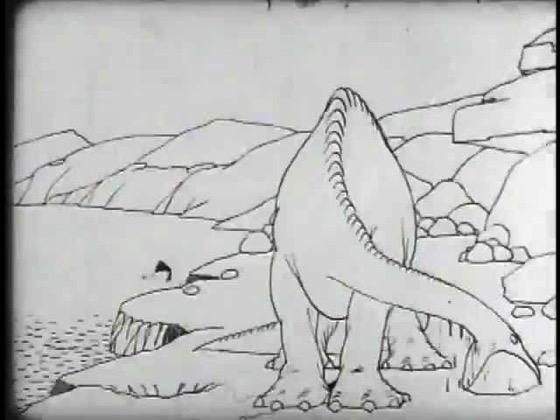A History of Screenwriting – 35 in a series – Gertie the Dinosaur (1914)
Gertie the Dinosaur is a 1914 animated short film by American cartoonist and animator Winsor McCay. It is the earliest animated film to feature a dinosaur. McCay first used the film before live audiences as an interactive part of his vaudeville act; the frisky, childlike Gertie did tricks at the command of her master. McCay’s employer William Randolph Hearst later curtailed McCay’s vaudeville activities, so McCay added a live-action introductory sequence to the film for its theatrical release. McCay abandoned a sequel, Gertie on Tour (c. 1921), after producing about a minute of footage.
Although Gertie is popularly thought to be the earliest animated film, McCay had earlier made Little Nemo (1911) and How a Mosquito Operates (1912). The American J. Stuart Blacktonand the French Émile Cohl had experimented with animation even earlier; Gertie being a character with an appealing personality distinguished McCay’s film from these earlier “trick films”. Gertie was the first film to use animation techniques such as keyframes, registration marks, tracing paper, the Mutoscope action viewer, and animation loops. It influenced the next generation of animators such as the Fleischer brothers, Otto Messmer, Paul Terry, and Walt Disney. John Randolph Bray unsuccessfully tried to patent many of McCay’s animation techniques and is said to have been behind a plagiarized version of Gertie that appeared a year or two after the original. Gertie is the best preserved of McCay’s films—some of which have been lost or survive only in fragments—and has been preserved in the U.S. Library of Congress‘ National Film Registry as being “culturally, historically, or aesthetically significant”. — Wikipedia
* A portion of each sale from Amazon.com directly supports our blogs ** Many of these books may be available from your local library. Check it out!
I teach several classes for the Stephens College Low-Residency MFA in Screenwriting, including History of Screenwriting. In fact, I created the curriculum for that course from scratch and customized it to this particular MFA in that it covers ‘Screenwriting’ (not directors) and even more specifically, the class has a female-centric focus. As part History of Screenwriting I, the first course in the four-class series, we focus on the early women screenwriters of the silent film era who male historians have, for the most part, quietly forgotten in their books. In this series, I share with you some of the screenwriters and films that should be part of any screenwriters education. I believe that in order to become a great screenwriter, you need to understand the deep history of screenwriting and the amazing people who created the career. — Dr. Rosanne Welch
